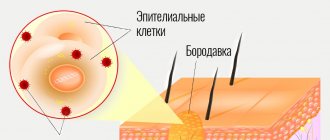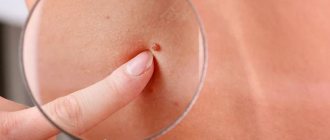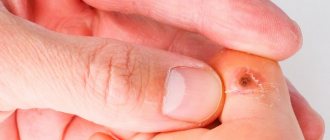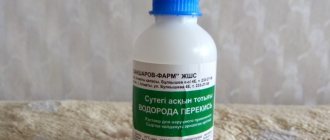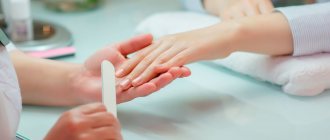Cracks in the feet rarely appear suddenly. As a rule, the appearance of such a crack is preceded by symptoms such as dryness and flaking of the skin. If the patient does not pay attention to these signs in a timely manner, the top layer of skin may rupture - a crack appears.
Depending on the depth of the cracks, podiatrists distinguish between superficial and deep cracks in the feet. Experts warn that if even superficial cracks appear, you must seek qualified medical help.
Many patients prefer to independently select remedies to solve the problem of cracked feet. However, such tactics will not bring the desired result - it is necessary, first of all, to identify the cause of the cracks and only then select the treatment methods necessary in each individual case.
Punctate keratolysis
Countries with hot microclimates are characterized by various types of infectious skin diseases. They are not always understood with an observant and piercing eye, sometimes making incorrect diagnoses and prescribing false treatments. Punctate keratolysis is an infectious lesion of the feet caused by continuous contact with tight shoes, which is manifested by the formation of pits on the epidermis of the feet and a very unpleasant odor from the feet, which forces the patient to consult a dermatologist.
In domestic dermatology, this nosology has not received sufficient attention, and many practitioners simply do not know about the existence of this disease, although they regularly encounter it in practice.
This disease was first described at the beginning of the twentieth century under the name Keratoma plantare sulcatum. The modern name Pitted keratolysis accurately reflects the clinical picture.
A survey of heterogeneous groups showed that in Russia the disease is observed in 9-12% of cases. Micrococcus sedentarius and Pseudomonas aeryginosa are considered to be the causative agents of punctate keratolysis. These bacteria produce specific proteolytic enzymes (one of them is keratinase), which dissolve the stratum corneum and form clearly visible erosions. Young people are more likely to get sick - athletes, military personnel, etc. Increased sweating of the feet contributes to the development of the disease.
Patients suffering from punctate keratolysis are usually bothered by an unpleasant odor of the feet, sweating, occasionally minor itching, and pain when pressing on the affected areas.
The pathological process is localized on the skin of the feet, especially the heels, and less often in the spaces between the toes. In this case, the presence of areas of hyperkeratosis with a large number of pinpoint depressions with a diameter of 2-6 mm, which look like small holes or “holes,” is noted. The depressions can merge to form erosions.
When moistened, the affected areas undergo maceration with a characteristic whitish color. The process is often localized symmetrically and is more pronounced in areas of pressure from shoes. Without treatment, punctate keratolysis can continue indefinitely, intensifying in the hot season. Very rarely, the disease can be detected on the palms.
Diagnosis is usually made clinically. Clinicians often regard the condition as dermophytosis and prescribe inadequate treatment. For laboratory diagnosis, a biopsy of the lesion with Gram or hexamethylenetetramine staining is used, as well as culture of the material on brain-heart agar under nitrogen and carbon dioxide. Differential diagnosis is made with mycosis of the feet.
To treat punctate keratolysis, antibiotics are used: erythromycin, Bactroban, clindamycin in the form of ointments, as well as benzoyl peroxide preparations. Dosage forms in some cases are alcohol solutions with antibiotics and paste-like preparations. Teymurov's paste and nitrofungin alcohol solution are very effective. The course of treatment is 7-14 days.
In severe cases, erythromycin can be administered orally. After treatment, it is important to carry out preventive measures, since the disease tends to recur. In addition, there is evidence that, over a long period of time, the causative agents of punctate keratolysis can cause sensitization.
It is recommended not to wear tight shoes, walk barefoot more often, wear cotton socks, wash your feet 2 times a day with antibacterial soap, dry your shoes daily, take measures to reduce foot sweating, and treat them with an alcohol-containing deodorant.
The question of the combination of punctate keratolysis and different types of mycosis of the feet, as well as treatment tactics in such cases, remains unexplored.
Causes of cracking and first signs
The cause of cracks in the feet is the loss of elasticity in the skin. Because of this, the skin becomes dry and begins to peel. Dry skin can be caused by a variety of reasons.
Experts identify internal and external causes of cracks in the feet.
Internal causes are, first of all, diseases. Both organ diseases (for example, the digestive system) and metabolic disorders in the body, as well as podological problems (fungus, hyperkeratosis, dermatitis, etc.). Separately, it is worth noting the effect of thyroid diseases and hormonal imbalances on the skin condition.
Patients with foot deformities, overweight people and those who adhere to strict unbalanced diets often face the problem of cracks in their feet - due to a lack of vitamins and microelements, the elasticity of the skin decreases.
External causes of cracks in the feet are those factors that affect the skin from the outside. These are, first of all, shoes (when wearing tight, compressive shoes, the likelihood of cracks in the skin increases), failure to comply with personal hygiene rules and improper care of the skin of the feet. Cracks on the feet often bother those who wear synthetic socks and tights, often walk barefoot and overuse exfoliating procedures without properly moisturizing the skin after them.
Causes of punctate keratolysis
The causative agents of the disease are microorganisms such as pseudomonas (or Pseudomonas aeruginosa) and spherical coccal microbes. Globular cocci, found everywhere, in the typical state of the body, do not pose a danger, however, once on the sweaty skin of the feet, they begin to dissolve the upper layers of the epidermis, accumulating in the resulting pits. Their collections prevent the human immune system from overgrowing erosive formations.
The causes of punctate keratolysis may be infection of the feet by Pseudomonas. The disease progresses in a different way. Needing a continuous flow of oxygen, the microorganism, after the formation of a crater on the epidermis, moves to another place on the foot, promoting the formation of new erosion.
In this case, small pinpoint pits begin to merge into one large one, which, when formed, begins to become inflamed. Blood leukocytes try to heal the source of inflammation, carrying out phagocytosis of the affected cells, however, microorganisms migrate to another place in the foot, and keratolysis develops.
Symptoms of the disease
The main signs of punctate keratolysis are the formation of pinpoint pits on the soles of the feet, very reminiscent of a fungal infection, which is why incompetent dermatologists are mistaken when making a diagnosis.
In addition, signs of exfoliative keratolysis include:
- a feeling of itching in the toes, an unpleasant persistent burning sensation;
- a whitish tint on erosive formations, which intensifies when the skin is wetted;
- hyperkeratosis of the feet, manifested in thickening of the skin in places from which microorganisms migrated;
- foul odor of feet;
- in advanced cases, the disease can manifest itself in the inner areas of the palms.
Risk group
The following patients are most susceptible to developing holes in their feet:
- Military personnel.
- People who play sports professionally.
- Persons who, due to their professional activities, are forced to wear shoes for a long time.
Men suffer from pathology much more often than women: their feet sweat more often and are exposed to unfavorable conditions.
People at risk need to be especially careful about the health of the skin on their feet. If you experience frequent and profuse sweating of your feet, you should carefully monitor their hygiene.
Diagnostics
Any dermatologist should know how to identify punctate keratolysis in a patient.
The data of a visual examination under a fluorescent lamp alone is unsatisfactory; it is necessary to take a scraping from the affected area of the foot in order to exclude mycosis, and conduct a culture to detect a certain type of microorganism that caused keratolysis of the punctate type.
Morphological studies are carried out over several days, after which the dermatologist receives the results, from which it is clear which microbes caused the disease. Depending on these data, a course of therapy is prescribed.
Why you won’t be able to heal a trophic ulcer on your own
The reason that the ulcer does not heal for a long time is the same as the reason for its initial occurrence: insufficient tissue nutrition. In the affected area, the ability to regenerate tissue is sharply reduced - which leads not only to the spread of pathology, but also to life-threatening complications. This is why it is so important to see a doctor on time.
Moreover, treatment of the trophic ulcer itself will be unsuccessful until you eliminate the main cause of its occurrence. And, as medical practice shows, no one has yet been cured of varicose veins and, especially, its complications at home.
Why attempts to self-medicate a trophic ulcer are life-threatening
Firstly, because in this way you will not only delay a timely visit to the doctor - and the wound will not only not shrink, but will also grow deeper into the tissue. And the purulent-necrotic process can spread all the way to bone tissue (in this case, trophism can cause the development of osteomyelitis ).
In addition, the lack of adequate medical care for trophic ulcers is fraught with complications such as:
- Malignant degeneration of a trophic ulcer
- Reduced mobility of the ankle joint (pronounced limitation of capacity - and, as a consequence, disability)
- Phlegmon or sepsis
Often, small trophic ulcers on the surface of the lower leg merge into one wound space. The patient may develop inguinal lymphadenitis, purulent thrombophlebitis or erysipelas of soft tissues.
How to treat punctate keratolysis
Correct clinical diagnosis is the key to ensuring that keratolysis is treated in the correct and effective ways. It is desirable that the disease be treated not only by a dermatologist, but also by a physiotherapist, and even a cosmetologist, since keratolysis of the punctate type must be dealt with comprehensively.
In order to get rid of the continuous moisture of the feet, the cosmetologist injects botulin or botulinum toxin into the sweat glands, which temporarily slows down the production of sweat in the patient.
If the patient has a history of hypersensitivity to botulinum, then punctate keratolysis is treated with physiotherapeutic methods. This treatment includes electro- or iontophoresis with aluminum chloride or silver.
In this case, the pad with the medicinal substance is placed casually on the soles of the feet. A pad with an electrode is placed on it, and, under the influence of current, the medicine is concentrated in the erosive pinpoint zones.
How does a trophic ulcer appear: prerequisites and mechanism of development
The main factor in the development of a non-healing ulcer is a serious violation of tissue nutrition. As you understand, with varicose veins , characterized by impaired venous outflow, this is exactly what happens.
Non-functioning venous valves cause blood to flow back (reflux). That is, blood no longer circulates from top to bottom, as in normal conditions. These hemodynamic features are both a consequence and a cause of varicose veins.
Due to the fact that blood stagnates in the tissues of the lower extremities, tissue nutrition deteriorates. The pathology of the venous system progresses, but the ulcer does not develop immediately. First, the skin of the lower leg (most often varicose ulcers occur in the lower third of the lower leg) becomes denser and acquires a characteristic glossy shine. Patients complain of increased swelling in the calf muscle, heaviness and a feeling of fullness.
The affected area begins to itch, small drops of lymphoid fluid appear on the surface of the skin (this occurs due to the development of local lymphostasis).
Then the patient notices increased hyperpigmentation of the skin. After a while, a “harbinger of a future ulcer” develops in the affected area - a whitish area of atrophied tissue. As soon as a person even slightly damages the area of atrophy (for example, touching it with the fabric of trousers), an ulcer appears in this place.
At first, the ulcer looks like a superficial wound with a crust, but as the pathological process progresses, it deepens into the soft tissues of the leg. In addition, its area is expanding.
Usually at this stage a person tries to heal the ulcer on his own using the usual methods (for example, regenerating ointments) - but he will fail. The wound surface becomes infected, begins to fester and ulcerate.
The contents of the separated biological fluid depend on the presence and number of attached bacteria. As a rule, at first the wound oozes bloody-lymphoid discharge, then the ichor becomes more cloudy, and finally acquires a characteristic rotting smell.
In some cases (for example, when the patient’s immunity is weakened), not only a bacterial, but also a fungal infection may occur. This fact further aggravates the person’s condition and somewhat worsens the prognosis.
Antibacterial drugs
Erythromycin has a good universal therapeutic effect for punctate keratolysis
Erythromycin has a good universal therapeutic effect for punctate keratolysis. This antibiotic and other drugs from the macrolide group are prescribed by a dermatologist both for oral administration and in the form of ointments and powders. An antibiotic destroys microorganisms, that is, the cause of the disease; therefore, it is impossible to neglect antibacterial therapy in any case. All other methods of treatment are auxiliary in nature.
ethnoscience
In combination with antibiotic therapy, it is possible to treat punctate keratolysis with folk remedies. There can be a lot of them. Regular tea can muffle foot sweating if you take baths with it every evening. Burnet-based lotions help a lot. An infusion is made from it by adding 2 tbsp to one glass of boiling water. dry grass.
A patient with pinpoint type keratolysis is recommended to wipe the soles of their feet with oak bark tincture. To prepare it, you need to take 1 part of crushed bark and 9% vinegar, mix and leave for 10-14 days, then strain. In its pure form, the composition of the infusion can burn the skin of the feet, therefore it must be diluted with boiled water in a 1:1 ratio.
Boric acid also helps a lot, which should be poured into socks at night, put them on and sleep all night. In the morning, you need to wash and treat your feet with a special deodorant.
Some remedies to reduce sweating of the feet are taken orally as an infusion. You can make a decoction based on dry inflorescences and leaves of blue St. John's wort. It is prepared in the following way: take 1 tsp. leaves and inflorescences of St. John's wort, pour one glass of boiled cold water over them, put on fire, boil, stirring, and then cook over low heat for 15-20 minutes. After this, infuse the decoction for half an hour and drink throughout the day.
Prevention of keratolysis
If the skin of the feet is characterized by excessive sweating, then a relapse of the disease is possible; therefore, to prevent keratolysis, certain rules of hygiene and behavior must be observed. It is necessary to exclude narrow shoes made from synthetic, non-breathable materials from your wardrobe, continuously use absorbent agents that block the release of sweat as much as possible, and wear socks only from natural materials. Special hygienic shoe insoles have an excellent preventive effect.
A deodorant based on alcohol and antibacterial components will help cope with hyperhidrosis (excessive sweating of the feet), but it should be used regularly, and not occasionally. In addition, continuous life in regions with a humid, hot average annual microclimate is contraindicated for patients with keratolysis in order to avoid recurrence of punctate-type keratolysis. The prognosis for treating the disease is favorable if the patient follows all medical prescriptions.
